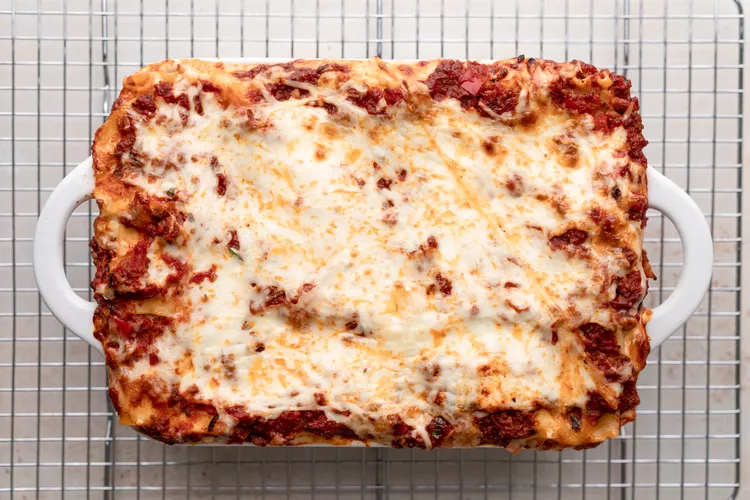This classic lasagna recipe is made with an easy meat sauce as the base. Layer the sauce with noodles and cheese, then bake until bubbly! This is great for feeding a big family and freezes well, too.
Everyone loves a good lasagna, right? It’s a great way to feed a crowd and a perfect dish to bring to a potluck. It freezes well. It reheats well. Leftovers will keep you happy for days.
Simply Recipes reader Alton Hoover sent me his favorite recipe for lasagna, which he has been cooking since his college days. Alton’s original recipe created enough lasagna for a small army so I halved it. What is posted here will easily serve eight people.
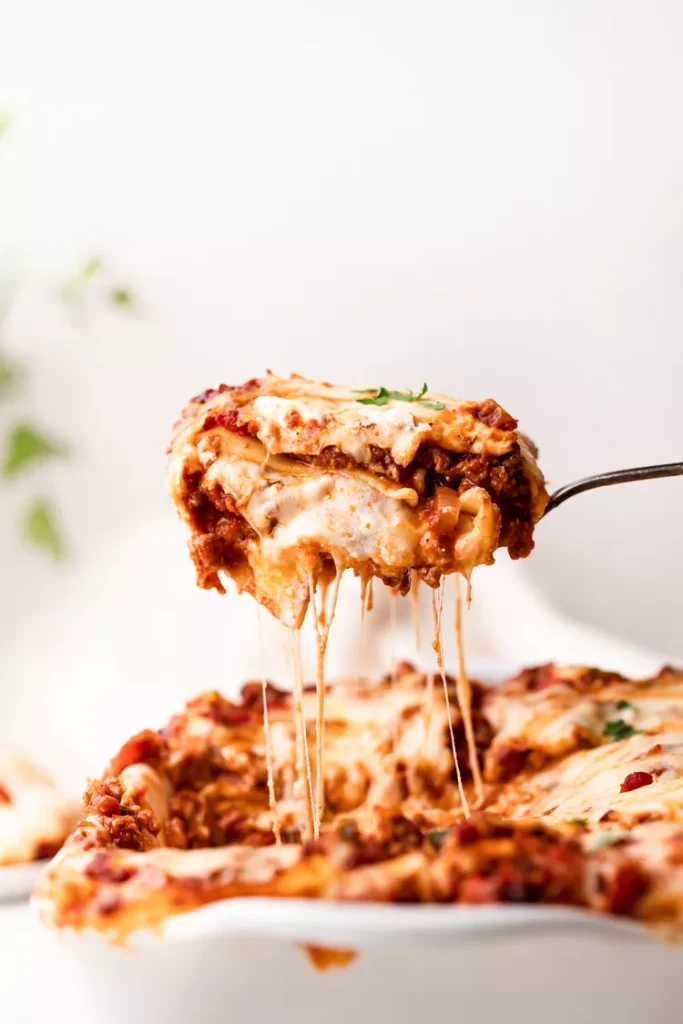
The Secret Behind This Classic Lasagna Recipe
From what I can tell, the secret behind Alton’s lasagna is the addition of a little sugar to the sauce and using a bit more cheese than most other recipes.
There are a few minor tweaks to his original recipe that I found necessary, such as adding a dash of wine vinegar to the sauce and changing the amount of Parmesan cheese.
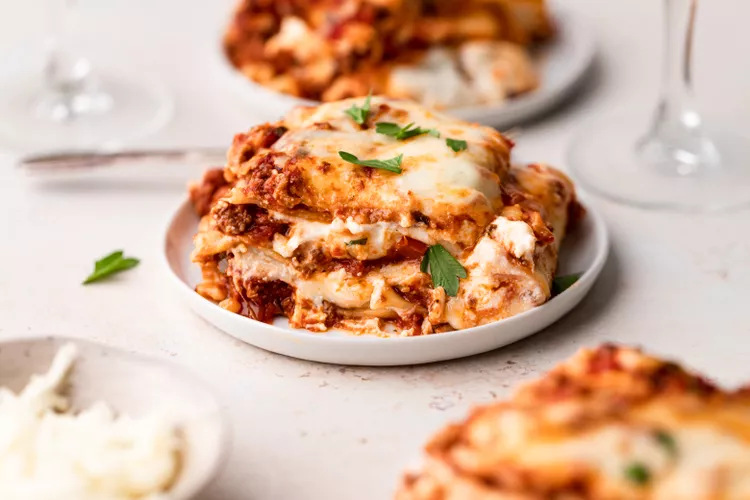
How to Make Lasagna
For this recipe, we are essentially making a thick, meaty tomato sauce and layering that with noodles and cheese into a casserole. Here’s the run-down:
Start by making the sauce with ground beef, bell peppers, onions, and a combo of tomato sauce, tomato paste, and crushed tomatoes. The three kinds of tomatoes gives the sauce great depth of flavor.
Let this simmer while you boil the noodles and get the cheeses ready. We’re using ricotta, shredded mozzarella, and parmesan—like the mix of tomatoes, this 3-cheese blend gives the lasagna great flavor!
From there, it’s just an assembly job. A cup of meat sauce, a layer of noodles, more sauce, followed by a layer of cheese. Repeat until you have three layers and have used up all the ingredients.
Bake until bubbly and you’re ready to eat!
How to Store and Reheat Leftovers
Half the pleasure of making a lasagna is enjoying the leftovers! The lasagna will keep in the fridge for at least 5 days. Reheat individual slices in the microwave, or warm the whole casserole (covered with foil) in the oven at 350°F until bubbly again.
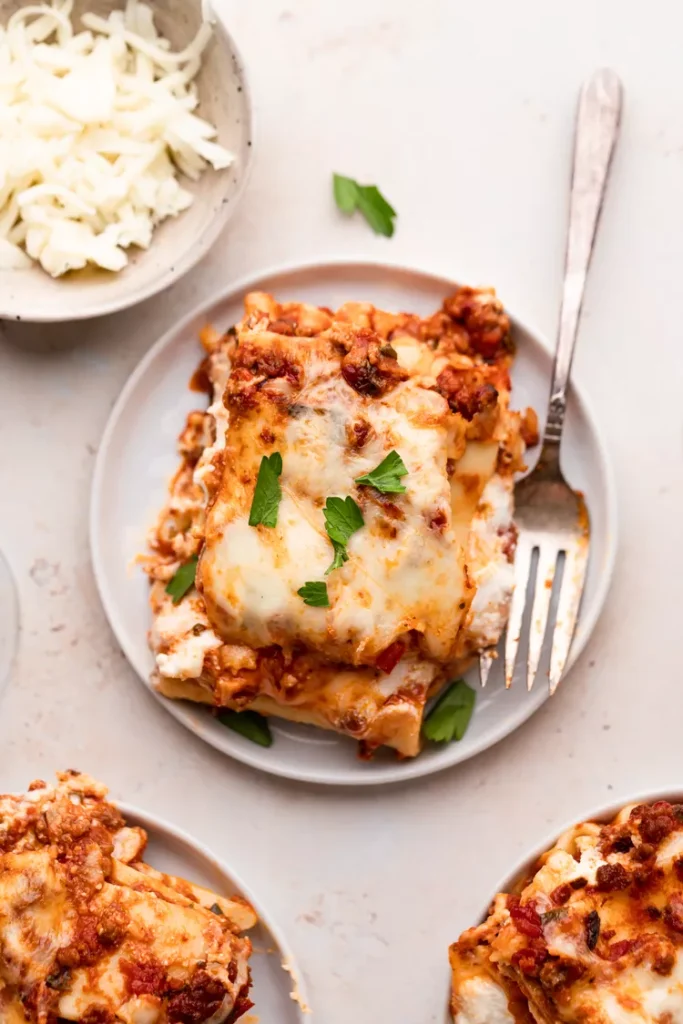
How to Freeze and Reheat Lasagna
To freeze an unbaked lasagna: Line the pan with foil before assembling, then assemble the lasagna as directly. Let cool completely, and then freeze until solid. Once frozen, lift the frozen lasagna block from the casserole dish, wrap it in more foil, then freeze for up to a month.
To reheat an unbaked frozen lasagna: Remove the lasagna from the freezer and unwrap all the layers of foil. Transfer to the original casserole dish, cover, and let it thaw in the fridge overnight. Once thawed, bake as directed.
To freeze baked lasagna: Line the pan with foil before assembling, then assemble and bake as directed. Let it cool completely, then freeze until solid. Once frozen, lift the frozen lasagna block from the casserole dish, wrap it in more foil, then freeze for up to a month.
To freeze baked lasagna: Line the pan with foil before assembling, then assemble and bake as directed. Let it cool completely, then freeze until solid. Once frozen, lift the frozen lasagna block from the casserole dish, wrap it in more foil, then freeze for up to a month.
To reheat a baked lasagna: Remove the lasagna from the freezer and unwrap all the layers of foil. Transfer to the original casserole dish, cover, and let it thaw in the fridge overnight. Once thawed, warm the whole casserole (covered with foil) in the oven at 350°F until bubbly again.
To freeze and reheat individual slices: Cut the baked and cooled casserole into slices and wrap each slice individually in foil. Combine them in a freezer storage bag and freeze for up to 1 month. Thaw overnight in the fridge. To reheat, unwrap from the foil, place on a microwave-safe dish, and warm in the microwave for a few minutes until bubbly.
Method
Put pasta water on to boil:
Put a large pot of salted water (1 tablespoon of salt for every 2 quarts of water) on the stovetop on high heat. It can take a while for a large pot of water to come to a boil (this will be your pasta water), so prepare the sauce in the next steps while the water is heating.
Brown the ground beef:
In a large skillet, heat 2 teaspoons of olive oil on medium-high heat. Add the ground beef and cook until it is lightly browned on all sides.
Remove the beef with a slotted spoon to a bowl. Drain off all but a tablespoon of fat.
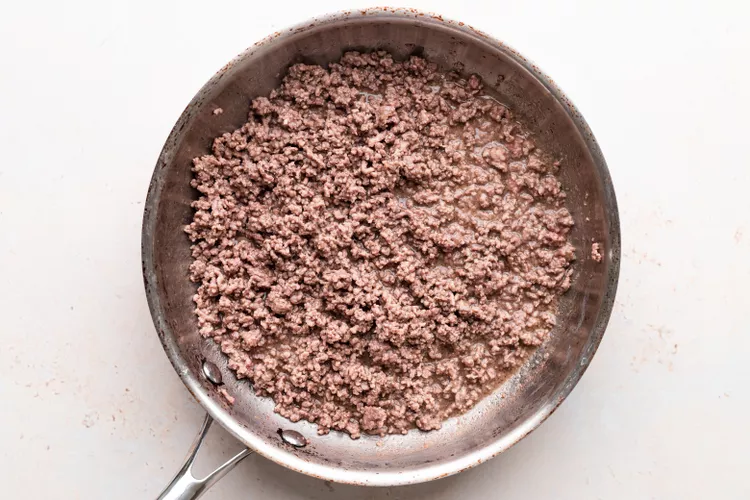
Cook the bell pepper, onions, and garlic; add back the beef:
Add the diced bell pepper and onions to the skillet (in the photo, we are using yellow bell pepper and red onions).
Cook for 4 to 5 minutes, until the onions are translucent and the peppers softened. Add the minced garlic and cook half a minute more.
Return the browned ground beef to the pan. Stir to combine, reduce the heat to low, and cook for another 5 minutes.
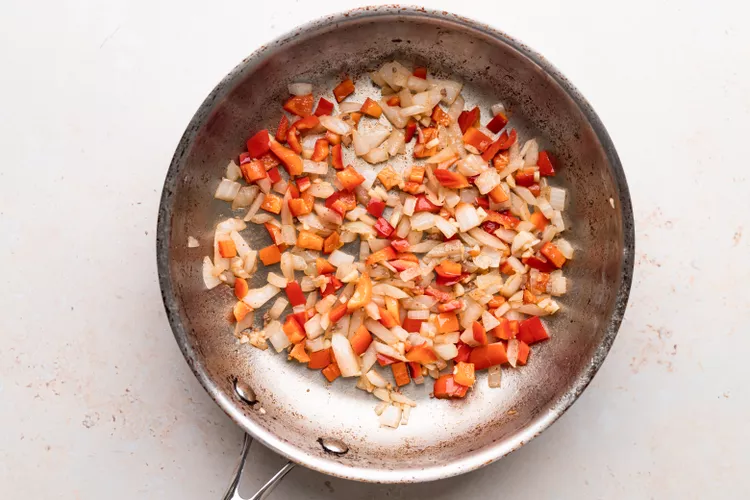
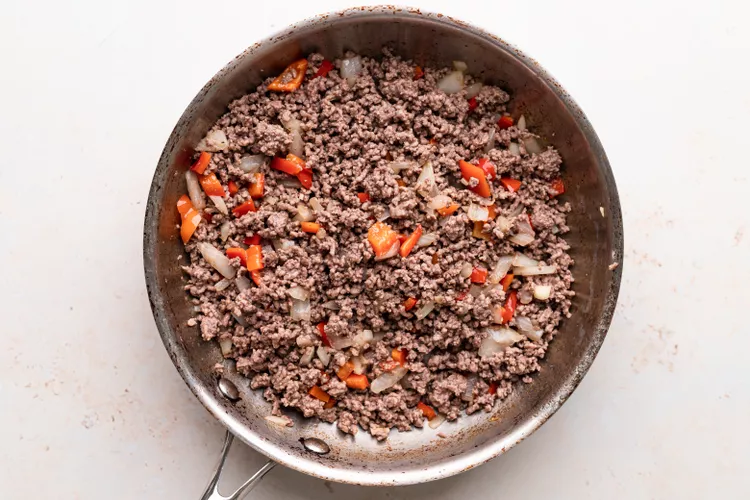
Make the sauce:
Transfer the beef mixture to a medium-sized (3- to 4-quart) pot. Add the crushed tomatoes, tomato sauce, and tomato paste to the pot.
Add the parsley, oregano, and Italian seasonings, adjusting the amounts to taste. Sprinkle with garlic powder and/or garlic salt, to taste.
Sprinkle with red or white wine vinegar. Stir in sugar, a tablespoon at a time, tasting after each addition. (The amount of sugar needed will vary, depending on how acidic your tomatoes are.)
Add salt to taste. Remember that you will later be adding parmesan, which is salty.
Bring the sauce to a simmer and then lower the heat to maintain a low simmer. Cook for 15 to 45 minutes, stirring often. Scrape the bottom of the pot occasionally, making sure nothing sticks to the bottom and scorches.
Remove from heat.
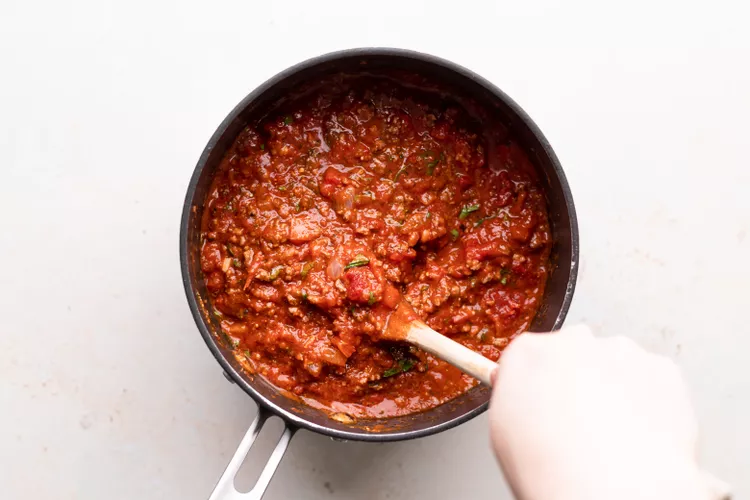
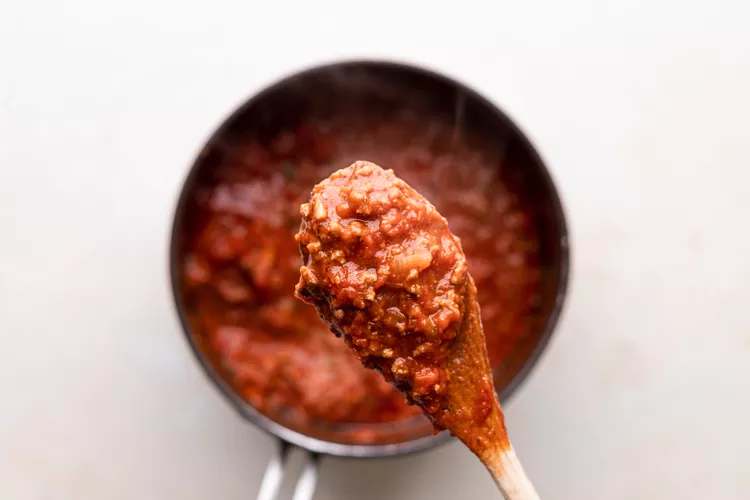
Boil and drain the lasagna noodles:
By now, the salted water you started heating in step one should be boiling. Add the dry lasagna noodles and cook them to al dente, per package directions. (Note: noodles may be cooked in advance.)
Stir the water often to prevent sticking. Make sure that the water remains at a full rolling boil during the entire cooking process, in order to prevent noodles from sticking.
When the noodles are done, drain them in a colander and rinse with cool water, gently separating any noodles that may be sticking together.
Spread a little olive oil on a large, rimmed baking sheet, and lay out the cooked noodles on this sheet, turning them once so that all sides get coated with some of the olive oil. This will prevent them from sticking together.
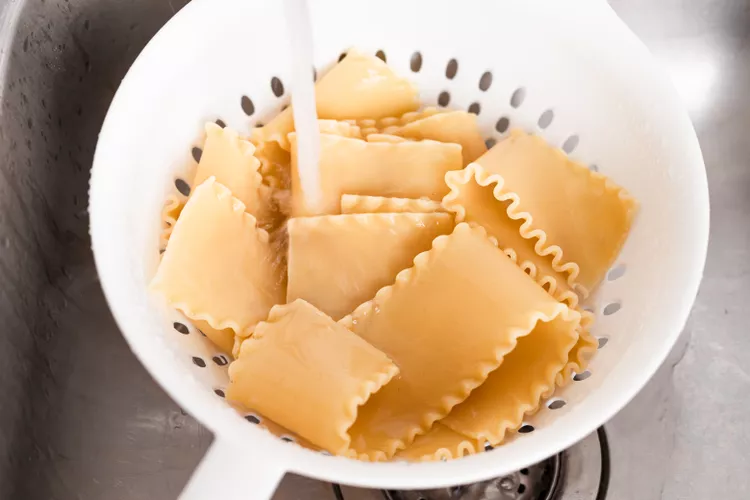
Preheat the oven to 375°F.
Assemble the lasagna:
In a 9×13-inch casserole or lasagna dish, ladle a cup of sauce over the bottom of the dish and spread it evenly. Arrange one layer of lasagna noodles lengthwise over the sauce (about 3 long noodles; the edges may overlap, depending on your pan). Ladle a third of the remaining sauce over the noodles.
Sprinkle a third of the grated mozzarella on top of the lasagna sauce. Add half of the ricotta cheese by placing cheese dollops every two inches. Sprinkle half of the grated parmesan cheese evenly over the top of the ricotta cheese.
Apply the second layer of noodles. Top it with half of the remaining sauce. Add half of the remaining mozzarella, the rest of the ricotta cheese, and the rest of the parmesan cheese.
Finish with a final layer of noodles. Spread the remaining sauce over the top layer of noodles and sprinkle with the remaining mozzarella cheese.
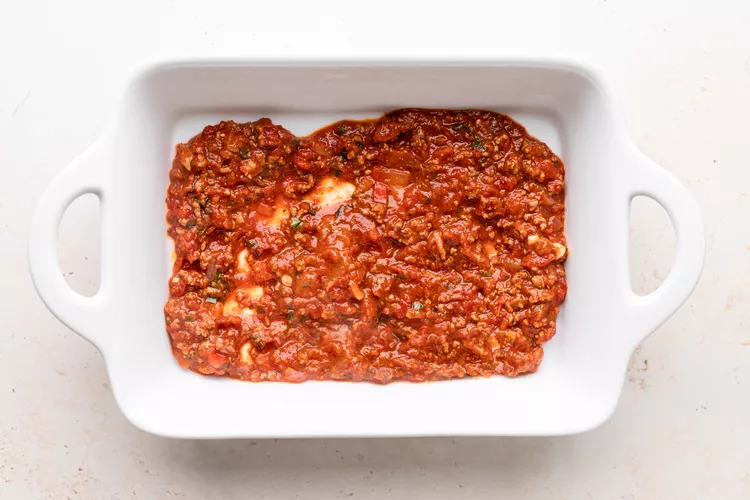

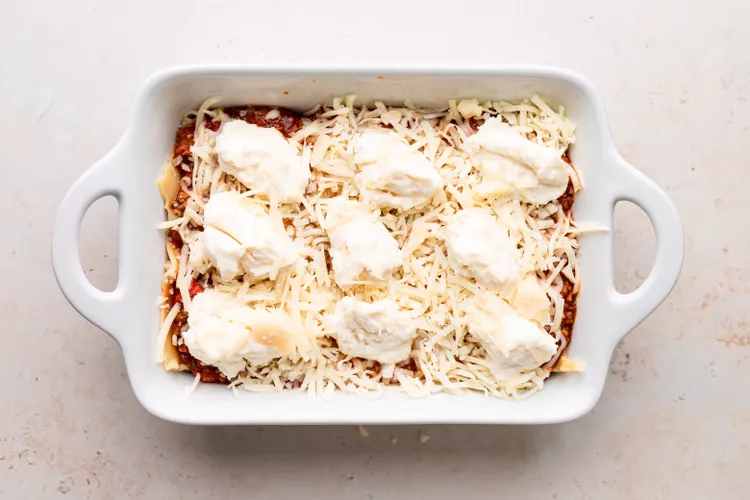
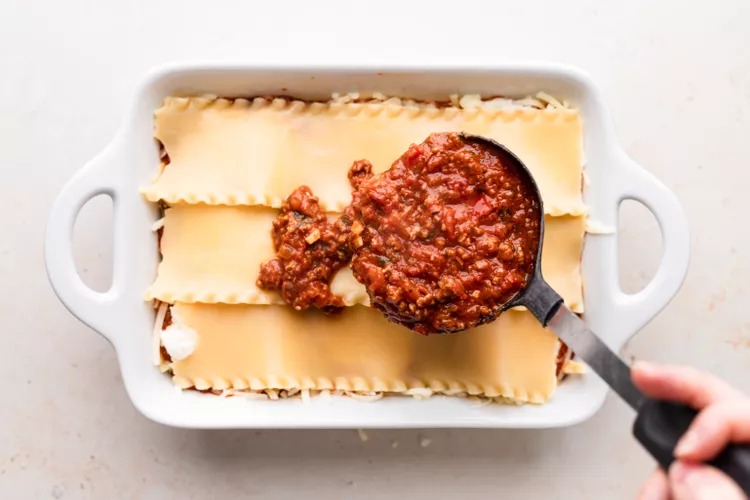
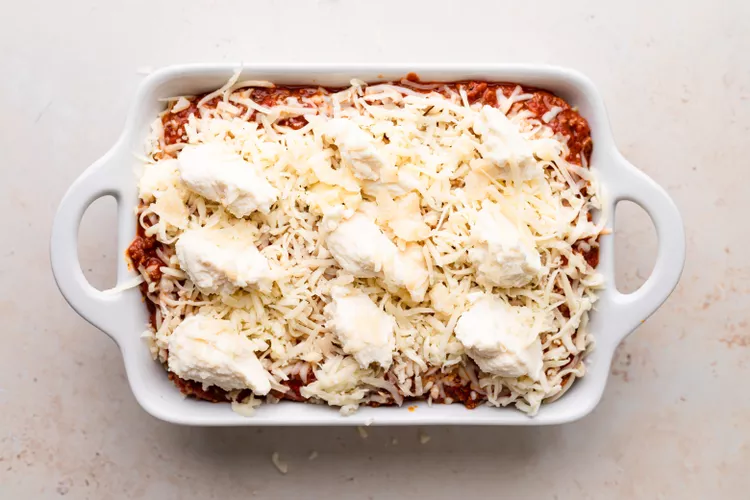
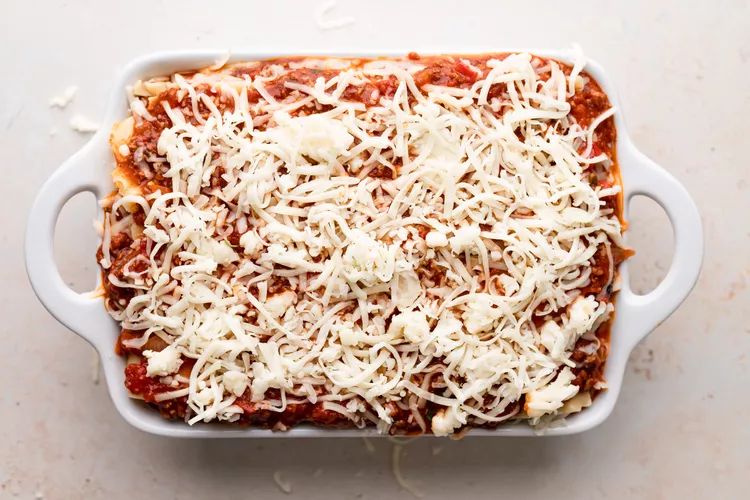
Bake:
Cover the lasagna pan with aluminum foil, tenting the foil slightly so it doesn’t touch the noodles or sauce. Bake at 375°F for 45 minutes. If you’d like more of a crusty top or edges, uncover the lasagna in the last 10 minutes.
Cool and serve:
Allow the lasagna to cool for at least 15 minutes before serving. Leftovers will keep for about 5 days. You can reheat lasagna in a conventional oven or microwave. While storing, leave the aluminum tent on. (Try to keep the aluminum foil from touching the sauce.)
Did you love the recipe? Leave us a rating and review below!
